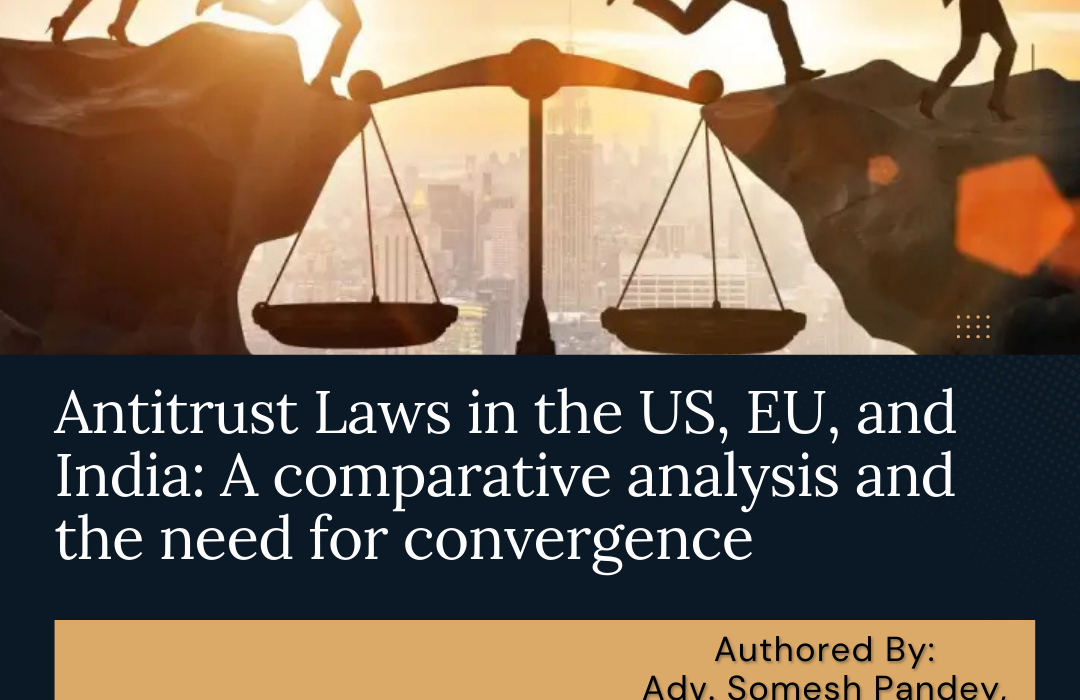COMPARATIVE ANALYSIS OF ANTITRUST LAWS IN THE US, EU, AND INDIA AND THE NEED FOR CONVERGENCE
Introduction
Antitrust laws play a crucial role in maintaining market fairness and promoting economic efficiency. However, their application varies across jurisdictions, leading to challenges in global trade and business operations. While the United States (US), the European Union (EU), and India have distinct legal frameworks, there is an increasing need for convergence to ensure consistency in enforcement.
A key aspect of antitrust jurisprudence is the differentiation between the Per Se Rule and the Rule of Reason. The former deems certain agreements inherently illegal, whereas the latter involves a comprehensive analysis of economic impact.
This article examines the historical background, theoretical perspectives, and comparative analysis of antitrust law across jurisdictions of the US, EU, and India while exploring the need for global convergence.
Historical background
Antitrust law traces its origins to the late 19th and early 20th centuries, primarily in response to monopolistic practices and anti-competitive conduct.
In the US, the Sherman Act, enacted in 1890, is the oldest federal antitrust law and primarily addresses anti-competitive agreements and monopolistic practices. This was later supplemented by the Clayton Act and Federal Trade Commission Act of 1914, which focus on specific business activities such as mergers, price discrimination, tying arrangements, and exclusive supply agreements.
The EU’s antitrust law evolved from the Treaty of Rome (1957), which laid the foundation for the modern framework under the Treaty on the Functioning of the European Union (TFEU).
In India, the Monopolies and Restrictive Trade Practices Act (MRTP Act), 1969, was the first attempt at regulating monopolies. However, it was replaced by the Competition Act, 2002, to align with international best practices and ensure a more dynamic regulatory framework.
Theoretical perspectives
Antitrust law is guided by two primary economic schools of thought, i.e., the Harvard School and the Chicago School.
The Harvard School emphasizes structuralist principles, advocating for strict regulations to prevent market concentration and monopolization. This approach influenced early US antitrust jurisprudence, where courts were more inclined to break up large firms to promote competition.
The Chicago School, on the other hand, takes a more laissez-faire approach, arguing that market forces and efficiencies should guide antitrust enforcement rather than rigid structural presumptions.
This shift became evident in US antitrust cases from the late 20th century, particularly with the US Supreme Court’s decision in Continental T.V., Inc. vs. GTE Sylvania Inc., 433 U.S. 36 (1977), which underscored economic efficiencies as a justification for certain business practices.
The EU follows a mixed approach, incorporating elements from both schools. While structuralist principles play a role, EU antitrust enforcement, particularly in abuse of dominance cases, places significant emphasis on economic analysis and effects-based assessments.
India’s competition law is still evolving, but its framework incorporates elements from both perspectives. The Competition Act 2002 reflects an inclination toward a behavioral approach rather than outright structural remedies, allowing for case-by-case assessments.
Comparative analysis
The US follows a structured legal approach with the Sherman Act distinguishing between the Per Se Rule and the Rule of Reason. Under the Per Se Rule, certain practices such as price-fixing, bid-rigging, and market allocation are deemed illegal without requiring further economic analysis. The landmark case United States vs. Trenton Potteries Co., 273 U.S. 392 (1927), reinforced that price-fixing is inherently anti-competitive. Conversely, the Rule of Reason requires courts to assess whether a restraint unreasonably restricts trade by analysing pro-competitive and anti-competitive effects. Chicago Board of Trade vs. United States, 246 U.S. 231 (1918), established the balancing approach, while Leegin Creative Leather Products, Inc. vs. PSKS, Inc., 551 U.S. 877 (2007), marked a significant shift by applying the Rule of Reason even to minimum resale price maintenance agreements.
In the EU, antitrust laws are primarily governed by Article 101 of the TFEU, which prohibits agreements that prevent, restrict, or distort competition. Unlike the US, the EU does not strictly follow the Per Se Rule but presumes certain hardcore restrictions, such as cartels, to be anti-competitive unless justified by economic benefits. In Cartes Bancaires vs. European Commission (C-67/13 P, 2014), the court held that agreements restricting competition by “object” are presumed illegal. The EU also adopts an effects-based approach, which considers the actual or potential anti-competitive effects of agreements. Metro SB-Großmärkte GmbH & Co. KG vs. European Commission (Case 26/76) laid the foundation for evaluating economic efficiencies, while European Night Services vs. European Commission (T-374/94, T-375/94, T-384/94, T-388/94) established that restrictive agreements can be justified based on significant economic benefits.
India’s competition law framework under the Competition Act, 2002, follows a hybrid approach, incorporating elements of both the Per Se Rule and the Rule of Reason. Section 3(3) presumes horizontal agreements such as cartels and bid-rigging to be anti-competitive. The Supreme Court of India in Excel Crop Care Limited vs. Competition Commission of India (2017) 8 SCC 47 held that cartelization warrants strict scrutiny as it has no redeeming economic benefits. However, vertical agreements, such as exclusive supply and distribution agreements, are assessed under Section 3(4) based on their impact on competition. The Automobile Dealers Association vs. Competition Commission of India (2018) case highlighted the necessity for economic analysis before declaring vertical restraints anti-competitive.
Unlike India’s competition law framework, which operates under a single legislation and enforcement agency, the US follows a multi-agency and multi-legislation approach. In the US, two key federal agencies oversee antitrust enforcement: the Antitrust Division of the US Department of Justice (DoJ) and the Federal Trade Commission (FTC). While the DoJ functions under the executive branch of the government, the FTC is an independent administrative body, similar to the Competition Commission of India (CCI).Both the DoJ and FTC independently enforce these laws; however, in cases requiring criminal prosecution, only the DoJ has the authority to take legal action.
Unlike the US system, the TFEU does not explicitly outline the institutional framework for competition enforcement; instead, the European Council established this structure and assigned the European Commission (EC) the responsibility of ensuring compliance with the Treaty and overseeing the implementation, enforcement, and development of EU competition law and policies.
India’s competition law framework is a blend of both systems. The Competition Act, along with the powers and functions of the CCI, closely aligns with the provisions of the Treaty and the authority of the EC. However, despite similarities between the enforcement structures of India, the US, and the EU, they differ significantly in terms of enforcement levels and effectiveness.
The need for convergence in Antitrust Law
Given the globalization of markets, convergence in antitrust law is imperative to ensure predictability and efficiency in enforcement. The divergence in the application of the Per Se Rule and the Rule of Reason across jurisdictions creates legal uncertainties for multinational corporations. Harmonizing legal standards would prevent forum shopping and conflicting interpretations, leading to a more streamlined regulatory approach. Furthermore, enhanced cooperation between competition authorities could strengthen cross-border enforcement mechanisms, ensuring more effective regulation of global anti-competitive practices. A unified legal framework would also foster business confidence, encouraging investments in international markets by reducing regulatory uncertainty and compliance burdens.
Conclusion
While the US, the EU, and India share the common objective of promoting competition, their legal interpretations of the Per Se Rule and Rule of Reason vary. The US adopts a strict bifurcation, the EU employs an effects-based approach, and India blends elements from both systems. As globalization advances, the necessity for a harmonized antitrust law framework becomes increasingly evident. Convergence would not only facilitate smoother trade and business operations but also ensure fair and consistent enforcement of competition law principles worldwide.
Authored by
Adv. Somesh Pandey



